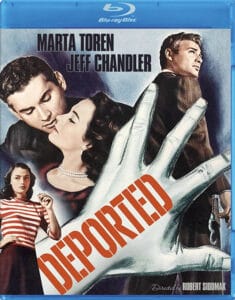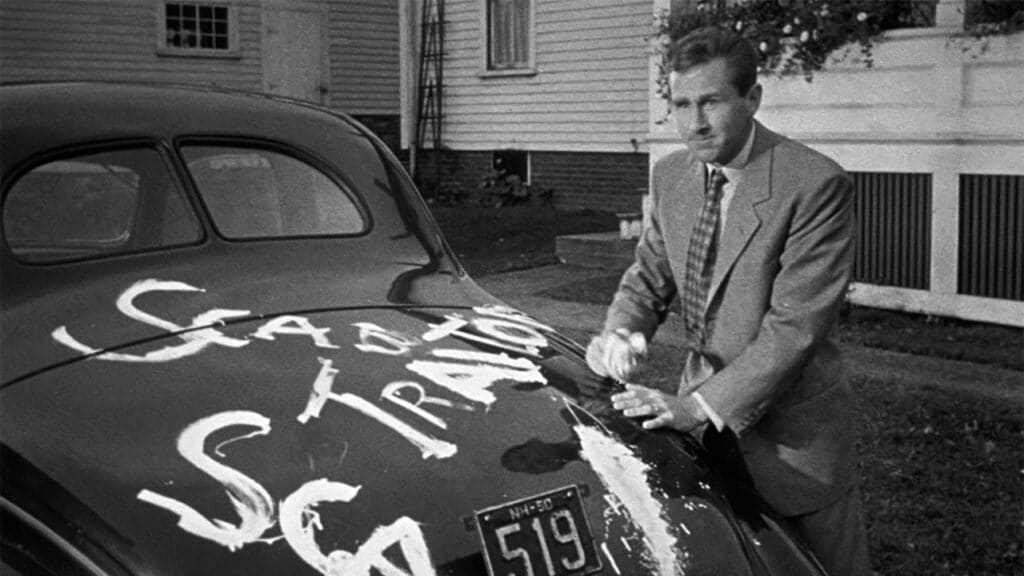

Capital and Labor Clash in
The Whistle at Eaton Falls
Siodmak shot this film in 1950 shortly after Deported but it wasn’t released until the next year, apparently because Columbia was skittish about it. This remarkable drama, almost invisible in film history, owes its existence to producer Louis de Rochement, a pioneering newsreel producer who moved into features that stressed real locations and ripped-from-the-headlines stories. He was crucial in the application of documentary and neorealist techniques into noir films.
The Whistle at Eaton Falls (1951) isn’t noir but something rare as a unicorn: a serious drama about capital and labor, in the early 1950s, from a major studio. Let’s pause to consider that Elia Kazan’s On the Waterfront (1954) was celebrated as a breakthrough drama three years later, and it’s a condemnation of union corruption by organized crime. Although controversial, that was the kind of story that could be endorsed by the big studio owners who created and enforced the blacklist.
The Whistle at Eaton Falls is a very different animal because while it features corrupt plotting on both sides of the labor/management divide, it not only declares that unions are necessary bulwarks of democracy but comes out and says that an effective union leader could be just as effective a company president as the so-called “experienced” white-collar lackeys. Shot on real locations in Pennsylvania (de Rochemont’s home state) with much footage of people who live and work there and locals drafted as extras, this film is very much de Rochement territory, subtitled “A Drama of Real Life” and complete with an authoritative narrator to introduce us to the story.
We’re told that the community suffered a serious setback when Granite Shoes closed its factory. “Granite Shoes Fit the World” says the sign, which doesn’t sound too auspicious; it’s reminiscent of the cement galoshes reputedly used by underworld figures like those in On the Waterfront. After Granite sank, the factory whistle was transplanted to Doubleday Plastics, which faces bankruptcy because its useless doohickeys are undersold by competitors. Granite shoes and plastics – perhaps there’s a hidden message about obsolescence and trivia as everyone depends on the factory life whose whims may kill them.
The drama gets underway in a scene introducing several characters and the central dialectic. Owner Daniel Doubleday (Donald McKee) tries to convince union boss Brad Adams (Lloyd Bridges) that new molding machines will be the factory’s salvation, but only if half the workers are laid off, at least temporarily. The impasse reaches a surprising twist when, upon the owner’s death, his widow (silent screen star Dorothy Gish) appoints Brad as new boss over the wishes of union-busting executive Dwight Hawkins (Russell Hardie).
Hawkins symbolizes capitalist skulduggery as he attempts to gain power by manipulating a faction of disgruntled workers under the angry Webster (Murray Hamilton), who resents being passed over for Brad’s old job as the union leader. When Hawkins and Webster have a secret meeting (though in public) to arrange their mutual satisfaction, the film implies that both are equally corrosive snakes to be found in all social organizations and especially in the parasitic symbiosis of Capital and Labor. Webster should be called a retrograde bourgeois individualist while Hawkins is just a fatcat.
The thrust of the story is Brad’s step-by-step, desperate and claustrophobic education on the ins and outs of capitalism and running a factory. He arrives at two solutions: the brutal initial one of closing the factory temporarily to overhaul a moribund system, and the long-term innovations of plucky engineer-inventors whose better mousetrap will make the business viable again. The magic solution involves a patent-able new molding device and a vital new doohickey: TV dials!
Understandably, the mass of laid-off workers only sees, bitterly, the first of these solutions in action, and the grimmest section of the story is the documenting of economic effects all over the town. The workers are ripe for Webster’s cynical manipulations in the name of workers’ solidarity, and the Hawkins/Webster schism comes perilously close to inevitability as tyrants poise to usurp the benevolently minded leaders who agonize over the ungrateful people.
Siodmak must have felt at home connecting the dots of how the environment’s social systems entrap its characters and leave its struggling protagonists almost helpless in the face of virtually systemic evil. But this is a more optimistic story that posits good old American know-how and community loyalty as saving the day, if temporarily and by the skin of its dentures.
Several writers include de Rochemont’s wife, Virginia Shaler, and humorist Leo Rosten. The impressive array of actors includes Ernest Borgnine, Anne Francis, Carlton Carpenter (heading a square dance in an almost MGM-musical sequence), James Westerfield, Diana Douglas, Anne Seymour, and Arthur O’Connell. Lenore Lonergan has an interesting presence as a spunky union representative. Spindly, squawky Doro Merande is a highly recognizable comic player, often a sniffy spinster, who has little to do here but it’s nice to see her.
The bonus material includes an illustrated presentation of the half-hour score by Louis Applebaum, a look at how damage on the nitrate print plus one positive print were addressed, a brief memoir of the producer by his grandson, and a well-informed audio commentary by historian Alan K. Rode. Among other topics, Rode compares the community square dance sequence to those in John Ford films and also calls attention to Siodmak’s uncredited contributions to On the Waterfront.
The booklet mentions a statement by de Rochemont that he intended this film “to dramatize in documentary fashion that labor is an indispensable ingredient in our capitalist system.” As regards our capitalist system, the picture lost money and practically nobody has heard of it. The film belongs to his ambitious series of projects on serious hot-topics, such as the “passing for white” drama Lost Boundaries (Alfred L. Werker, 1949).
De Rochemont could escape being painted as “red” by his other well-connected projects, like the FBI-approved Cold War spy drama Walk East on Beacon (Werker, 1951), written by some of the same people who worked on The Whistle at Eaton Falls; the biopic Martin Luther (Irving Pichel, 1953), financed by the Lutheran Church; and the animated Animal Farm (Joy Batchelor and John Halas, 1954), funded by the CIA! These and other projects would be great excavations for Flicker Alley, who have already restored and released the producer’s Cinerama titles.
The Whistle at Eaton Falls would be Siodmak’s last production in America. Having tasted work in Italy on Deported, he’d return there for The Crimson Pirate (1952), a Warner Brothers item for producer-star Burt Lancaster. Siodmak remained in Europe for the rest of his career, especially in West Germany, as we mentioned in our recent review of The Devil Strikes at Night (1957). We hope the rediscovery of his work continues.

